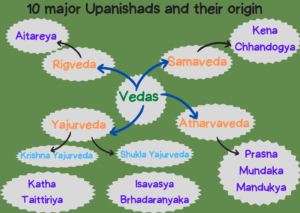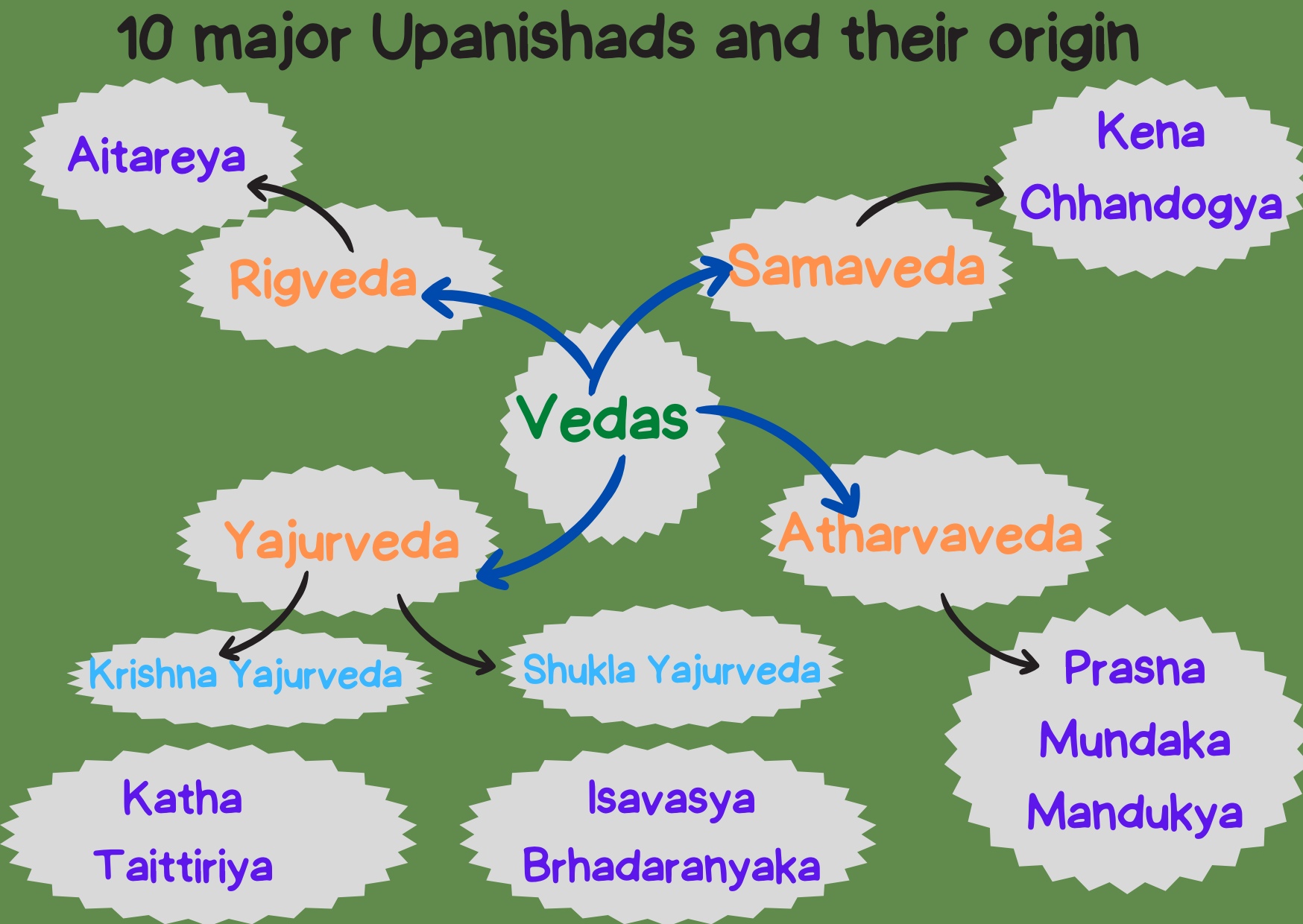Introduction
The Upanishads were written between 700 and 400 BCE in the Sanskrit language. They contributed to the ancient people’s advancement in spiritual understanding. Vedanta also known as the Upanishads means “end of the Vedic period”. There are roughly 200 Upanishads, the most famous of which are the Aitareya Upanishad, Brhadaranyaka Upanishad, Chandogya Upanishad, Isha Upanishad, Katha Upanishad, Kausitaki Upanishad, Kena Upanishad, Maitri Upanishad, Mandukya Upanishad, Mundaka Upanishad, Prashna Upanishad, Sveta.
Birth of Upanishads
The Vedas could only be read and translated by Brahmins, regular people had great difficulty understanding them. Saints, therefore, wrote a summarized version of the Vedas that included additional queries and concepts in the form of Upanishads. The Upanishads were written at a time when there was a great deal of social, political, and economic unrest. The rural tribal civilization was in danger of extinction because the monarchy absorbed the people into urban life. In times of uncertainty, learnings from the Upanishads gave people peace, a sense of self-realization, and purpose.

Upanishads and Indian Society
The Upanishads are the repository of Hindu philosophy, and they served to uplift and maintain Hindus for a long period. Combining various Upanishads will give a good picture of the kind of civilization and way of life that existed during that era.
At that time, the kings were specialists in both administration and warfare. They made an effort to promote knowledge of Vedic religion and also provided sanctuary for wise men and sages.
The Upanishad era was characterized by a strong caste system. In terms of the Ashram system. Brahmacharya, Garhasthya, and Vanaprastha were more prevalent, while Sannyasa may also have been practised. The sanctity and integrity of each person’s private life were emphasized.
The status of women in Hindu society during that era was relatively high. During this time, females participated in spiritual discussions. Gargi and Maitreyi were famous women who participated in such discussions and gave their views regarding various spiritual topics.
Learnings from Upanishads
The Upanishads are thought to be the authentic teachings of the sages of ancient India.
Learnings from the Upanishads include:
- The philosophy of human spiritual realization, including the meaning of life, existence, birth, and death, is addressed in the Upanishads.
- It explained the complicated truth of existence and how a person can correct his thinking and be inspired to think differently from the inner soul’s perspective.
- It enabled people to examine their beliefs and give their relationships more meaning.
- The Upanishads describe the understanding of Brahman and Atman’s self-existence. Atman is a particular soul, while Brahman is the all-pervading soul.
- People learned about their being and how Brahman and Atman combined formed the substance of “permanence” (which existed) through the Upanishads.
- The four doctrines of dharma, karma, samsara and moksha are the foundation of the Upanishads and are well explained in these texts.
- According to the Upanishads, a spiritually aspirational person must think about the symbolic sacrifices that occur in the mind rather than concentrating on external sacrifices.
- Last but not least, the Upanishads explain the self-realization theory. By realizing the purpose of life, people might lessen their sorrow and suffering.
Interesting Facts
- The best place to learn about self-realization and life’s realities is from the Upanishads.
- The impact of the Upanishads was not limited to India; it also extended to other nations.
- Although there are about 200 Upanishads, the majority of Hindu literature only mentions 108 of them.
- These Upanishads were among the earliest intellectual writings ever discovered; they even predated the Bible and the Qur’an by 800 and 1300 years, respectively.
- The Upanishads claim that Hindu sages united several Gods because they believed in unity.
- Agni, Indra, and other Vedic deities are compared to the highest truth and given a spiritual purpose.
- The development of various Vedanta that differed from the Brahman and Atman aspects was aided by the Upanishads.
Summary
The most important learning from the Upanishads-The final triumph, the victory of the soul over matter and man over nature, helped to establish, sustain, and perpetuate a vast heritage of spirituality. This was achieved, through the courageous pursuit of logical conclusions and intuitive, undetectable encounters outside the realm of reason. The experiences received from these learnings merged into a single principle that helped in human development. Upanishads are one of the oldest spiritual texts in Indian history, which helped man to live a life and build a society.
Frequently Asked Questions
1. What do Dharma, Karma, Samsara, and Moksha Mean?
Ans: Karma denotes a person’s response to an action. Dharma refers to a person’s obligations and responsibilities to society. Samsara, the cycle of both life and death, arises. Moksha is the ultimate goal of departing from the cycle of rebirth and death.
2. Who is the Upanishads’ Author?
Ans: The Upanishads’ author is still a mystery. The Upanishads are said to have been written by several authors. The scriptures were written with the help of famous sages like Aruni, Balaki, Sanatkumara, Yajnavalkya, and others.
3. Give the four Ashramas of the later Vedic Era.
Ans: The 4 ashrams of the Vedic period are-
- Brahmacharya: A phase in the Gurukul, the education process.
- Grihastha-A man was supposed to have a wife and children. Have a family life.
- Vanaprastha: A stage of life during which a person was supposed to put aside materialistic ambitions and relocate to the forests.
- Sanyasa: A man who abandons material interests to pursue exclusively spiritual objectives.
4. Give the names of the four Vedas. Which Veda is the Oldest?
Ans: The Rig Veda, Sama Veda, Yajur Veda, and Atharva Veda are the four Vedas of the Vedic era. The oldest of them all is the Rig Veda.
